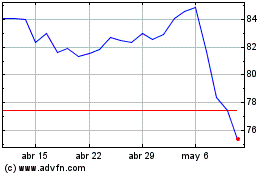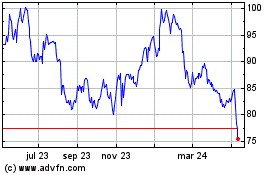Pioneer of Walkman targets premium market dominated by Bose and
Beats
By Takashi Mochizuki
This article is being republished as part of our daily
reproduction of WSJ.com articles that also appeared in the U.S.
print edition of The Wall Street Journal (October 29, 2018).
TOKYO -- When Ichiro Takagi took over Sony Corp.'s audio
business seven years ago, he found the staff took pride in being
the global No. 1 in headphones, in terms of units sold. But he was
appalled at how many were $10 headphones sold for minimal profit at
grocery stores.
"What's the point of that? Where's our brand image?" Mr. Takagi
recalls telling employees.
Fast forward to this fall and the international electronics show
in Berlin, where Mr. Takagi was showing off the latest version of
his flagship product, a $350 pair of noise-canceling wireless
headphones.
The premium-price headphone market has been largely dominated by
Bose, the industry pioneer popular with frequent fliers, and Beats,
the fashion-savvy brand acquired by Apple Inc. for $3 billion in
2014. All share the challenge of wooing listeners who already get
free earbuds with their smartphones.
Sony said in May it has 11% of the headphone market in terms of
revenue, the third-largest slice. It didn't name the top two
companies.
The audio business -- where Sony has been a player since the
1950s -- is a prime example of how it got back to profitability in
recent years, even in a traditional hardware business that once
looked like a lost cause. For the year that ended in March, sales
for the audio unit rose for the first time in 20 years after having
fallen some 80% from the peak.
More important for Chief Executive Kenichiro Yoshida, the
home-electronics division, including audio and televisions (another
former money loser), posted operating profit of nearly $800 million
for the year, helping Sony achieve record overall profit. Mr.
Yoshida is hoping roughly to match that record in the current
fiscal year: Quarterly earnings coming Tuesday will give a progress
report.
The rise of Spotify Technology SA and other music services has
been good for headphone makers, increasing the time consumers spend
listening on the go. Streaming companies such as Spotify and
France-based Deezer offer high-resolution services that have
expanded the market for higher-quality headphones costing hundreds
or even thousands of dollars.
Recent product releases by Sony include a $280 pair of
earphones; an $8,500 portable music player targeted at audiophiles
goes on sale in December, with a gold-plated volume controller and
a battery system designed to reduce noise.
In the first generation of portable MP3 music players, "the
quality of the music sources was poor," Sony audio executive
Yoshinori Matsumoto said. "We couldn't push high-end listening
devices because they would highlight the coarseness." Now, better
technology has "made high-quality music more accessible both to
customers and creators," he said.
Audio has paralleled Sony's highs and lows through its 72-year
history. The Walkman in 1979 set off a revolution in portable
electronic devices, with Sony in the lead. But in the 2000s, Sony
let Apple and the iPod seize the dominant position.
By 2011, the Tokyo company was nearly giving up on its old
hardware products. "The attitude of management at that time was
like, 'If you're so-so, that's fine,' " Mr. Takagi, the audio-unit
chief, said.
That changed under then Chief Executive Kazuo Hirai, who took
over in 2012, and Mr. Yoshida, who was chief financial officer
under Mr. Hirai and became CEO this year. They pushed the audio
team to drop cheap products and focus on a few high-end models.
Mr. Takagi says the new management scrapped an organizational
chart that had separate groups of engineers focusing on
subcategories like car audio. "I told them to look around the whole
industry to come up with products that consumers are willing to pay
extra for," he said.
Sony says the $350 headphones can detect the owner's facial
shape, hairstyle and presence of glasses, as well as pressure
changes in an airplane, all to optimize the noise-canceling
feature.
"Our latest model is distinctly the best in terms of
noise-canceling technology," says Mr. Takagi, who is in the habit
of visiting electronics stores to eavesdrop on what customers are
saying to salespeople. "It's obvious if you ask your ears."
Another Sony rival, especially for younger customers, is Beats.
Mr. Matsumoto says the competition has led Sony to stress fashion
as well as sound quality. "In China, headphones have become part of
the outfit for young people, and they have to have a style that
people want to wear all the time, even when they are not
listening," he said.
With the changes in Sony's audio strategy, more young engineers
are raising their hands to join the department. "Sony was becoming
exciting when I was looking for a job," says Mayo Tsuji, a
24-year-old Walkman planner who joined Sony two years ago.
Mr. Takagi said there is more innovation to come, such as
headsets that stream music from the internet on their own without
having to be hooked up to a smartphone.
"Audio will remain a profitable business so long as we keep
listening to music," Mr. Takagi said. "If we remain as a strong and
respected player in the industry, than the whole company will be
too because audio is the origin of Sony."
Write to Takashi Mochizuki at takashi.mochizuki@wsj.com
(END) Dow Jones Newswires
October 29, 2018 02:47 ET (06:47 GMT)
Copyright (c) 2018 Dow Jones & Company, Inc.
Sony (NYSE:SONY)
Gráfica de Acción Histórica
De Mar 2024 a Abr 2024

Sony (NYSE:SONY)
Gráfica de Acción Histórica
De Abr 2023 a Abr 2024
